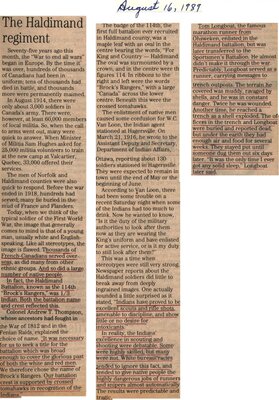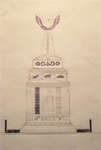"The Haldimand Regiment"
- Full Text
- The Haldimand regiment
Seventy-five years ago this month, the "War to end all wars" began in Europe. By the time it was over, hundreds of thousands of Canadians had been in uniform; tens of thousands had died in battle, and thousands more were permanently maimed.
In August 1914, there were only about 3,000 soldiers in Canada's army. There were, however, at least 60,000 members of local militia. So, when the call to arms went out, many were quick to answer. When Minister of Militia Sam Hughes asked for 25,000 militia volunteers to train at the new camp at Valcartier, Quebec, 33,000 offered their services.
The men of Norfolk and Haldimand countries were also quick to respond. Before the war ended in 1918, hundreds had served; many lie buried in the mud of France and Flanders.
Today, when we think of the typical soldier of the First World War, the image that generally comes to mind is that of a young man, usually white and English-speaking. Like all stereotypes, the image is flawed. Thousands of French-Canadians served overseas, as did many from other ethnic groups. And so did a large number of native people.
In fact, the Haldimand Battalion, known as the 114th "Brock's Rangers," was 1/3 Indian. Both the battalion name and crest reflected this.
Colonel Andrew T. Thompson, whose ancestors had fought in the War of 1812 and in the Fenian Raids, explained the choice of name. "It was necessary for us to seek a title for the battalion which was broad enough to cover the glorious past of both the white and red men. We therefore chose the name of Brock's Rangers. Our battalion crest is supported by crossed tomahawks in recognition of the Indians."
The badge of the 114th, the first full battalion ever recruited in Haldimand country, was a maple leaf with an oval in the centre bearing the words, "For King and Country - Haldimand. The oval was surmounted by a crown, and in the centre were the figures 114. In ribbons to the right and left were the words "Brock's Rangers," with a large "Canada" across the lower centre. Beneath this were the crossed tomahawks.
The enlistment of native men caused some confusion for W.C. Van Loon, the Indian agent stationed at Hagersville. On March 21, 1916, he wrote to the Assistant Deputy and Secretary, Department of Indian Affairs, Ottawa, reporting about 130 soldiers stationed in Hagersville. They were expected to remain in town until the end of May or the beginning of June.
According to Van Loon, there had been some trouble on a recent Saturday night when some of the Indians had too much to drink. Now he wanted to know, "Is it the duty of the military authorities to look after them now as they are wearing the King's uniform and have enlisted for active service, or is it my duty to still look after them?"
This was a time when stereotypes were still very strong. Newspaper reports about the Haldimand soldiers did little to break away from deeply ingrained images. One actually sounded a little surprised as it stated, "Indians have proved to be excellent scouts and rifle shots, amenable to discipline, and show little or no desire for intoxicants."
In reality, the Indians' excellence in scouting and shooting were debatable. Some were highly skilled, but many were not. White bureaucracies tended to ignore this fact, and tended to give native people the highly dangerous jobs of runners and snipers almost automatically. The results were predictable and tragic.
Tom Longboat, the famous marathon runner from Ohsweken, enlisted in the Haldimand battalion, but was later transferred to the Sportsmen's Battalion. He almost didn't make it through the war. Predictably, Longboat served as a runner, carrying messages to trench outposts. The terrain he covered was muddy, ravaged by shells, and he was in constant danger. Twice he was wounded. Another time, he reached a trench as a shell exploded. The officers in the trench and Longboat were buried and reported dead, but under the earth they had enough air and food for several weeks. They stayed put until someone dug them out six days later. "It was the only time I ever got any solid sleep," Longboat later said.
- Media Type
- Newspaper
- Item Types
- Articles
- Clippings
- Description
- "Seventy-five years ago this month, the "WAr to end all wars" began in Europe. By the time it was over, hundreds of thousands of Canadians had been in uniform; tens of thousands had died in battle, and thousands more were permanently maimed."
- Date of Original
- Summer 1989
- Subject(s)
- Personal Name(s)
- Hughes, Sam ; Thompson, Andrew T. ; Van Loon, W.C. ; Longboat, Tom.
- Corporate Name(s)
- Department of Indian Affairs.
- Local identifier
- SNPL002679v00d
- Collection
- Scrapbook #1
- Language of Item
- English
- Creative Commons licence
 [more details]
[more details]- Copyright Statement
- Public domain: Copyright has expired according to Canadian law. No restrictions on use.
- Copyright Date
- 1989
- Contact
- Six Nations Public LibraryEmail:info@snpl.ca
Website:
Agency street/mail address:1679 Chiefswood Rd
PO Box 149
Ohsweken, ON N0A 1M0
519-445-2954




